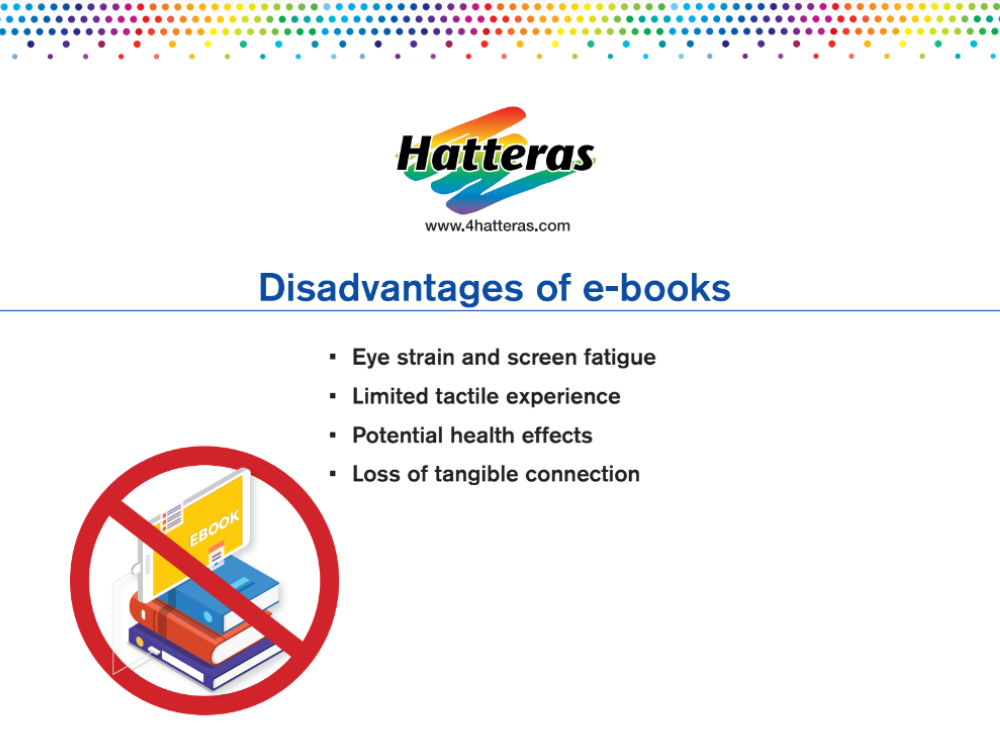E-books have transformed the reading landscape, offering readers unparalleled convenience and accessibility. Although there are many benefits, e-books also bring forth a set of drawbacks that should not be overlooked. This article delves into the disadvantages of using e-books vs traditional printed books.
Four Disadvantages of E-Books You Should Know
1. Eye Strain and Screen Fatigue
One of the primary disadvantages associated with e-books is the strain they can place on the eyes. Unlike print books with their paper pages, e-books are typically read on electronic devices such as e-readers, tablets, or smartphones. The screens of these devices emit blue light, which can cause eye fatigue and discomfort. Prolonged exposure to digital screens may lead to symptoms like dry eyes, blurred vision, and headaches.
The constant glare and flickering of screens can also induce eyestrain, making it challenging for readers to focus and retain information effectively. In contrast, print books, with their ink-on-paper format, offer a more natural reading experience that is less likely to strain the eyes.
2. Limited Tactile Experience
Print books provide a multisensory experience that e-books cannot fully replicate. The tactile sensation of flipping through the pages, feeling the weight of the book in one's hands, and the distinct smell of ink and paper contribute to a unique connection with the material. The act of physically turning pages can enhance the reading experience, creating a sense of progress and engagement.
Moreover, print books allow readers to easily navigate through the content by flipping back and forth, an advantage that e-books often lack. While e-readers and reading apps on electronic devices offer features like highlighting and note-taking, these digital interactions cannot fully replace the physicality and the sensory pleasure associated with print books.
3. Potential Health Effects
Reading e-books for extended periods can have adverse effects on overall well-being. The use of electronic devices exposes readers to artificial light, particularly blue light, which can disrupt sleep patterns and affect circadian rhythms. The blue light emitted by screens can suppress the production of melatonin, a hormone that regulates sleep, resulting in sleep disturbances.
Numerous studies have linked excessive screen time before bed to insomnia, decreased sleep quality, and an increased risk of developing sleep disorders. In contrast, reading print books before bedtime does not expose readers to the same level of artificial light, reducing the potential for sleep-related issues.
Furthermore, the physical posture adopted while reading e-books on devices can contribute to musculoskeletal problems. Holding a tablet or smartphone for prolonged periods often leads to poor ergonomics, straining the neck, shoulders, and wrists. The weight and design of electronic devices can exacerbate these problems, leading to discomfort and even chronic pain in some cases. In contrast, print books offer a more ergonomic reading experience, allowing readers to adopt a variety of positions and adjust their posture accordingly.
4. Loss of Tangible Connection
When comparing e-books vs printed books, printed books hold sentimental value for many readers. The physical presence of a personal library, the aesthetic appeal of beautifully designed covers, and the satisfaction of browsing bookshelves all contribute to a deep connection to literature. The act of lending or borrowing books, the ability to write personal messages or inscriptions inside them, and the joy of discovering forgotten bookmarks are all experiences unique to print books.
E-books, in contrast, lack the tangibility and aesthetic allure of a print book collection. While digital libraries offer convenience and space-saving benefits, a major disadvantage of e-books is that they cannot replicate the emotional bond readers feel with their physical bookshelves and collections. The absence of a physical object to hold, display, and share diminishes the personal connection readers have with their books.
E-Books vs Printed Books: Which Choice is Best For You
While electronic books have undoubtedly revolutionized the reading experience with their convenience and accessibility, it is important to consider the disadvantages of e-books vs printed books. Concerns such as eye strain, limited tactile experience, potential health effects, and the loss of a tangible connection to literature pose challenges for e-book enthusiasts.
The choice between e-books and print books ultimately boils down to personal preferences. Whether it is sensory pleasure, health considerations, or sentimental value, print books continue to hold a very special place in the hearts of avid readers around the world. While e-books offer undeniable advantages, readers should be mindful of the potential drawbacks and strike a balance that best suits their individual needs and reading preferences.
At Hatteras, we offer custom book printing services to fit all of your book printing needs. From textbooks, paperback books, picture books, children’s books, and more, we do it all. Contact us to learn more or get your book quote today.



